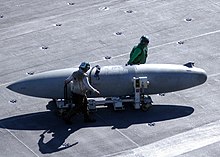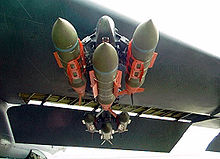Jettison (aviation)


In aviation, to jettison is to discard fuel, external stores or other expendable items.[1] The item is usually jettisoned by operating a switch or handle; external stores may be separated from the aircraft by use of explosive bolts or a mechanism.
- Fuel jettison
- Fuel jettisoning or fuel dumping is an emergency procedure used by crews of to reduce an aircraft's weight in an emergency when the aircraft needs to land safely.
- External stores jettison
- Some military aircraft can carry weapons (for example bombs or rockets) and fuel tanks on external hardpoints. The pilot can jettison them if necessary, so they do not inhibit actions during combat or in an emergency.
See also
References
- ^ Ginston 1986, p. 240
- Gunston, Bill (1986). Jane's Aerospace Dictionary. London: Jane's Publishing. ISBN 0 7106 0365 7.
